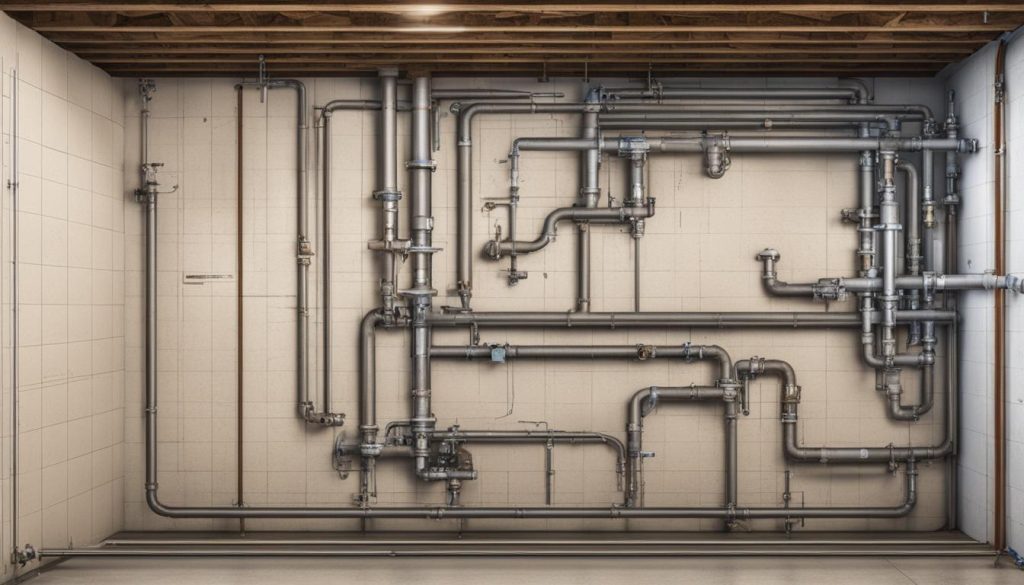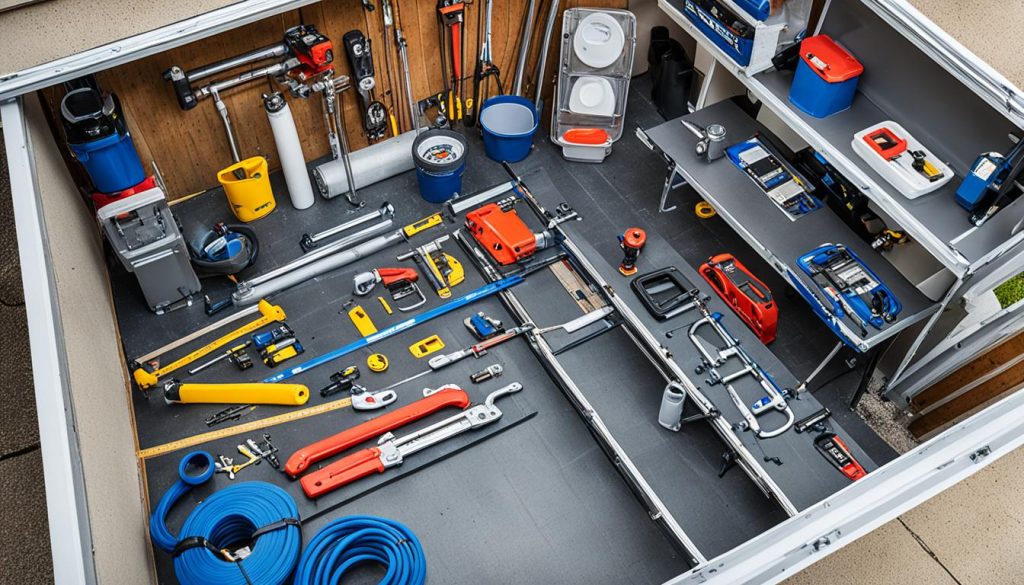Garage Plumbing Guide: Add Sinks & Toilets Easily
Did you know that adding plumbing to your garage can significantly increase its functionality and value? Not only does it provide convenience by allowing for the installation of sinks, toilets, and even a kitchenette, but it also enhances safety measures with immediate access to water in case of emergencies. Whether you’re looking to create a workshop, a home gym, or an additional living space, adding plumbing to your garage opens up a world of possibilities.
Before you embark on this DIY project, it’s important to have a solid understanding of the basics of plumbing, consider various factors that may affect the installation process, and carefully plan out your project. In this garage plumbing guide, I’ll walk you through everything you need to know to successfully add plumbing to your garage.
Key Takeaways:
- Adding plumbing to a garage increases functionality, convenience, and property value.
- Understanding plumbing basics, including the water supply and drainage system, is essential.
- Factors such as local building codes, plumbing systems, and distance between the house and garage should be considered before installation.
- A thorough site assessment and careful planning are crucial for a successful project.
- Installing garage plumbing requires specialized tools and materials, and professional help may be necessary for projects without existing plumbing.
Understanding Plumbing Basics
Before embarking on a garage plumbing project, it’s important to have a solid understanding of the basics. Plumbing involves two primary segments: the water supply system and the drainage system.
The water supply system is responsible for bringing fresh water into the garage. This includes connecting pipes to the main water source and installing fixtures such as sinks, showers, or toilets. It’s essential to ensure proper water pressure and flow to meet the needs of the garage.
The drainage system, on the other hand, focuses on expelling waste and used water out of the garage. This system includes pipes, traps, and vent systems. Understanding the role of vent pipes is crucial as they help maintain proper pressure and prevent sewer gases from entering the garage.
Each plumbing fixture in the garage requires both components – an inlet for fresh water and an outlet for waste disposal. It’s important to design and install the plumbing system in a way that promotes efficient and safe water usage and waste disposal.
Plumbing Basics Overview:
- Water supply system: Brings fresh water into the garage.
- Drainage system: Expels waste and used water out of the garage.
- Vent pipes: Maintain proper pressure and prevent sewer gases from entering the garage.
- Inlets and outlets: Each fixture requires both components for water supply and waste disposal.
Sample Diagram of Plumbing Basics:
| Water Supply System | Drainage System |
|---|---|
| Water Source | Waste Disposal |
| Pipes | Pipes |
| Fixtures (Sinks, Toilets, etc.) | Vent Pipes |
Having a strong foundation in plumbing principles allows for a better understanding of the concepts, components, and considerations involved in installing plumbing in a garage.
Factors to Consider Before Installing Plumbing
Before embarking on a garage plumbing project, it is crucial to consider several important factors to ensure a successful installation. These factors include:
Understanding Local Building Codes and Obtaining Permits
Complying with local building codes is essential when undertaking any plumbing project. Each jurisdiction may have specific requirements and regulations regarding plumbing installations. It is important to thoroughly research and understand these codes to ensure that your project meets the necessary standards. Additionally, obtaining the required permits is crucial to ensure that your garage plumbing is legal and up to code.
Exploring Different Types of Plumbing Systems
There are various types of plumbing systems available, and it is important to choose the one that best suits your garage’s specific needs. Common options include traditional copper or PVC piping, as well as PEX (cross-linked polyethylene) piping, which offers greater flexibility and durability. Each system has its own advantages and considerations, so it is beneficial to research and consult with plumbing professionals to determine the most suitable option for your garage.
Evaluating the Distance Between the House and Garage
The distance between your main house and the garage plays a significant role in your plumbing project. The longer the distance, the more piping material will be required, which can impact both the cost and logistics of the installation. Additionally, the distance may affect the water pressure and flow rate in the garage, so it is important to consider this when planning your plumbing system.
Considering Soil Type and Existing Underground Utilities
During the planning stages, it is crucial to assess the soil type in your garage area. Different soil types have varying drainage capabilities, which can affect the functionality of your plumbing system. Additionally, it is important to take into account any existing underground utilities, such as gas lines or electrical wires, to avoid any potential conflicts or damage during the installation process.
Factors to Consider Before Installing Plumbing
| Factors | Description |
|---|---|
| Local Building Codes and Permits | Compliance with local building codes and obtaining the necessary permits. |
| Types of Plumbing Systems | Exploring different plumbing system options and selecting the most suitable one. |
| Distance Between House and Garage | Evaluating the distance to determine the amount of piping material required and potential impact on water pressure. |
| Soil Type and Underground Utilities | Considering soil type and the presence of existing underground utilities to ensure proper drainage and avoid conflicts. |
By carefully considering these factors, you can ensure a well-planned and successful garage plumbing installation that meets all requirements and provides reliable functionality.
Site Assessment and Planning
Before starting the installation process, a thorough site assessment is necessary to ensure a successful plumbing project in your garage. Assessing the site will help identify potential challenges and determine the optimal plumbing system and pipeline route.
Evaluating Potential Challenges
During the site assessment, it is important to evaluate various factors that could impact the plumbing installation in your garage. Consider the following:
- Distance between the main house and the garage: The distance between the main house and the garage can affect the length of the pipeline and the cost of materials. It is important to plan accordingly and factor in any additional requirements or challenges that may arise.
- Soil type: Different soil types can pose different challenges during excavation and pipe installation. Clay or rocky soil may require special equipment or techniques to ensure proper placement of the pipes.
- Existing structures or utilities: Take note of any existing structures or utilities that may be present in the vicinity of the planned pipeline route. This includes underground electrical lines, gas lines, and other utility connections. It is essential to avoid damaging or interfering with these systems during the installation process.
Determining the Best Pipeline Route
Once potential challenges have been assessed, the next step is to determine the optimal pipeline route for your garage plumbing system. Consider the following factors:
- Landscape disturbance: Minimizing disturbance to the landscape is important, as it helps maintain the aesthetics of your property. Look for the most direct route that minimizes the need for excessive excavation or removal of vegetation.
- Depth requirements: Depending on the local building codes and regulations, you may need to consider the required depth for the pipes. Ensure that the pipeline route meets the depth requirements to ensure optimal functionality and compliance.
- Vehicular traffic: If the pipeline route crosses areas with vehicular traffic, it is crucial to plan the installation in a way that ensures the pipes are protected and not exposed to potential damage from vehicles.
Choosing the Optimal Plumbing System
When it comes to choosing the optimal plumbing system for your garage, consider the current and future usage of the space. Determine whether you require a simple system with sinks and toilets or a more elaborate system with a full kitchenette. Additionally, consider the maintenance requirements and potential for future expansion or modifications. Consulting with a professional plumber can help you identify the most suitable plumbing system for your garage.
With a comprehensive site assessment and thoughtful planning in place, you can proceed with confidence to install plumbing in your garage, enhancing its functionality and value.
Installing Plumbing in a Garage
When it comes to installing plumbing in your garage, you’ll need a set of specialized tools and materials to get the job done right. First and foremost, gather piping material, a measuring tape, pipe cutter or saw, soldering torch and flux (if using copper pipes), wrenches and pliers, and potentially a trencher for digging.
If your garage already has existing plumbing, the process becomes a bit easier. Start by shutting off the main water valve, then locate the water and drainpipe in the garage. Plan the installation carefully, considering the layout and functionality you desire. Next, cut and connect the pipes, ensuring a secure and leak-free connection. Finally, it’s important to test for any leaks before proceeding further.
However, if your garage doesn’t have existing plumbing, it may be best to hire a professional plumber to handle the project. They have the expertise and experience to navigate the complexities involved in setting up plumbing from scratch. By entrusting the project to a professional, you can ensure that the installation is done efficiently and up to code.
Whether you choose to tackle the installation yourself or hire a professional, adding plumbing to your garage can greatly enhance its functionality and convenience. It opens up possibilities for additional fixtures, such as sinks, toilets, and even a kitchenette, making your garage a versatile space that meets your needs.
- Investing Wisely: How Windows & Doors in Boost Property Value and Financial Health - April 24, 2025
- The Financial Impact of Personal Injuries: Why Legal Help Matters for Business Owners - April 16, 2025
- The Hidden Financial Costs of Domestic Assault: What Business Owners Need to Know - April 16, 2025













